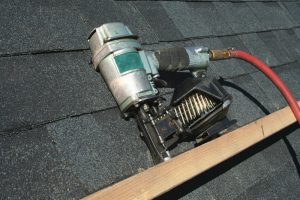Print a Sign-In Sheet | Spanish Version
 Nail guns have replaced hammers in wood frame construction. They are powerful, easy to operate, and boost productivity for nailing tasks. Nail guns are a leading cause of injury among residential carpenters and are responsible for an estimated 37,000 emergency room visits each year of which 68% are occupationally related. Puncture wounds to the hands and fingers are most common, but more serious injuries and deaths have occurred from misusing nail guns.
Nail guns have replaced hammers in wood frame construction. They are powerful, easy to operate, and boost productivity for nailing tasks. Nail guns are a leading cause of injury among residential carpenters and are responsible for an estimated 37,000 emergency room visits each year of which 68% are occupationally related. Puncture wounds to the hands and fingers are most common, but more serious injuries and deaths have occurred from misusing nail guns.
All nail guns have the potential to cause serious injury. Using a nail gun with a bump or automatic trigger, also known as contact trip trigger, can result in unintended nail discharge. Other risks include lack of training, working too quickly, and keeping the trigger squeezed when not nailing. Using a nail gun with a single shot or full sequential trigger reduces the risk of injury.
How to prevent nail gun injuries
Workers can talk to their employer about nail gun safety and prevention. Employers can take several steps to prevent nail gun injuries.
- Use full sequential trigger nail guns.
- Provide training.
- Establish nail gun work procedures.
- Provide personal protective equipment (PPE).
- Encourage reporting and discussion of injuries and close calls.
Employers and workers should provide first aid immediately and seek medical attention for nail gun injuries, even if an injury appears to be minimal.
Centers for Disease Control and Prevention. The National Institute for Occupational Safety and Health (NIOSH). Workplace Safety & Health Topics. Nailing Down the Need for Nail Gun Safety. (2020, November 30).
Retrieved from https://www.cdc.gov/niosh/newsroom/feature/nailgunsafety/default.html
KEMI does not assume liability for the content of information contained herein. Safety and health remain your responsibility. This information is to be used for informational purposes only and not intended to be exhaustive or a substitute for proper training, supervision or manufacturers’ instructions/recommendations. KEMI, by publication of this information, does not assume liability for damage or injury arising from reliance upon it. Compliance with this information is not a guarantee or warranty that you will be in conformity with any laws or regulations nor does it ensure the absolute safety of any person, place or object, including, but not limited to, you, your occupation, employees, customers or place of business.

